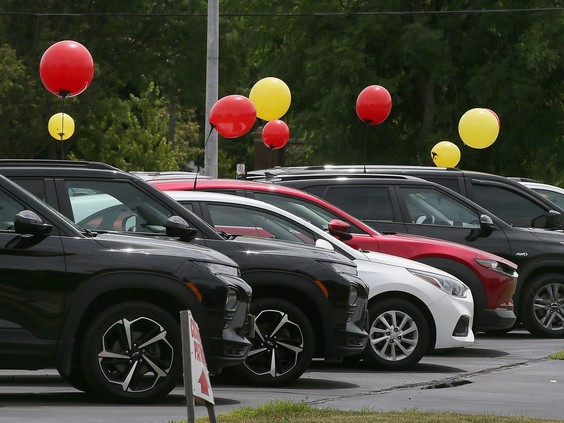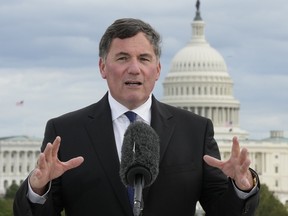Politics
Trade Tariffs Drive Up Used Car Prices as Inventory Declines

U.S. tariffs, both enacted and proposed, have led to a notable decline in vehicle production across North America, resulting in dwindling inventory levels within both the used and new car markets. According to the second quarter price index report from Auto Trader, this situation is driving up prices for consumers who rely on used vehicles.
Baris Akyurek, vice-president of insights and intelligence at Auto Trader, stated, “Tariffs are having a direct impact on the car market.” Typically, the used car market sees prices peak early in the year and decline thereafter. This year, however, the introduction of tariffs created increased demand, which led to a rise in prices. As of June, used car prices increased by 3.6 percent year-over-year, with an average transaction price reaching $37,664. From May to June, prices rose by 0.6 percent, marking the fourth consecutive monthly increase.
In contrast, new car prices fell by 3.5 percent year-over-year, averaging $64,445. Month-over-month, prices decreased by 0.5 percent in June, as manufacturers absorbed some of the tariff costs while relying on a significant inventory of vehicles produced before tariffs were announced.
The psychological impact of tariffs is evident, with 50 percent of consumers in June indicating that tariffs influenced their decision to purchase either a new or used vehicle. Akyurek noted that 38 percent of these consumers opted to buy used vehicles instead, which has intensified demand and further strained inventory levels.
The report highlighted that used car inventory has declined by 16.8 percent, while new car inventory contracted by 12 percent. Akyurek emphasized, “These are not insignificant numbers in an industry that doesn’t see that much change year-over-year.” This reduction in inventory has contributed to a supply and demand imbalance, with new car sales rising by 5.6 percent above expectations as consumers rushed to make purchases before anticipated price increases due to tariffs.
Looking ahead, North American vehicle production is expected to decrease by at least 500,000 units in 2025. The impact of tariffs is evident, with automakers such as Mazda, BMW, and Nissan announcing they will not ship specific models built in the U.S. to Canada due to tariff implications. Akyurek remarked, “The marketplace right now is very complex and uncertain,” noting that some dealerships have opted not to increase orders for 2025 or have decided to maintain production levels from 2024.
Inventory levels have dipped below the healthy average of 60 days, now averaging just 57 days nationally. There is significant variation among brands, with Subaru at the lowest inventory level of 27 days, while Jeep holds the highest at 97 days. Other brands from the Detroit Three report similar disparities, such as Chrysler at 67 days, Dodge at 93 days, and Ford at 63 days.
Akyurek explained that the decline in new car production will negatively affect the used car market, as 50 percent of used vehicle sales involve trade-ins. The used car market is still recovering from a production loss of 1.5 million vehicles during the COVID-19 pandemic. With 75 percent of cars manufactured in North America sold domestically, any production declines will have both short- and long-term repercussions.
Another complicating factor is the weak Canadian dollar, which has made shipping Canadian vehicles to the U.S. more appealing. Although a 25 percent tariff currently mitigates this flow, any reduction of tariffs or a trade deal could reopen this pipeline.
Akyurek indicated that while automakers have so far resisted price increases amid existing inventory, these will become unavoidable if a trade agreement is not reached or if tariffs are permanently instituted. He stated, “Assuming there’s a 15 percent tariff based on what we’ve been seeing, companies can’t absorb that for good. The profit margins in the industry aren’t that big.”
He concluded that without significant changes, price increases in the used car market are likely to persist, stating, “The inventory constraints will extend to 2027. I don’t see a change resulting in downward prices even if we get trade clarity for a couple more years.”
-

 World3 months ago
World3 months agoScientists Unearth Ancient Antarctic Ice to Unlock Climate Secrets
-

 Entertainment3 months ago
Entertainment3 months agoTrump and McCormick to Announce $70 Billion Energy Investments
-

 Lifestyle3 months ago
Lifestyle3 months agoTransLink Launches Food Truck Program to Boost Revenue in Vancouver
-

 Science3 months ago
Science3 months agoFour Astronauts Return to Earth After International Space Station Mission
-

 Technology2 months ago
Technology2 months agoApple Notes Enhances Functionality with Markdown Support in macOS 26
-

 Top Stories1 week ago
Top Stories1 week agoUrgent Update: Fatal Crash on Highway 99 Claims Life of Pitt Meadows Man
-

 Sports3 months ago
Sports3 months agoSearch Underway for Missing Hunter Amid Hokkaido Bear Emergency
-

 Politics2 months ago
Politics2 months agoUkrainian Tennis Star Elina Svitolina Faces Death Threats Online
-

 Technology3 months ago
Technology3 months agoFrosthaven Launches Early Access on July 31, 2025
-

 Politics3 months ago
Politics3 months agoCarney Engages First Nations Leaders at Development Law Summit
-

 Entertainment3 months ago
Entertainment3 months agoCalgary Theatre Troupe Revives Magic at Winnipeg Fringe Festival
-

 Politics1 week ago
Politics1 week agoShutdown Reflects Democratic Struggles Amid Economic Concerns





















